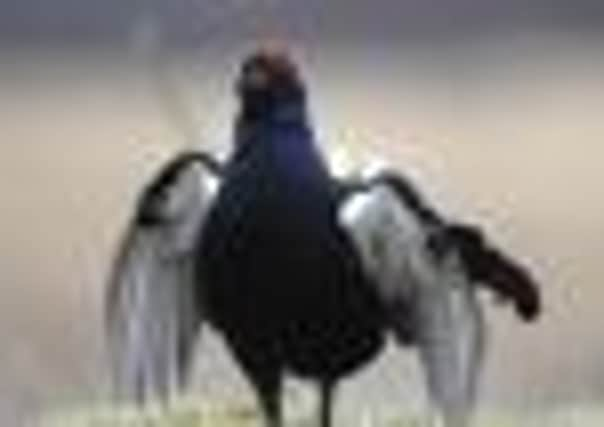Delight as threatened black grouse numbers take flight


Statistics show a 70 per cent rise in black grouse in the Borders between 2010 and 2011, a 37 per cent increase in Speyside, and a 31 per cent rise in Dumfries and Galloway.
The birds, famed for their unusual mating dance, known as a lek, are red-listed as a species of high conservation concern. But surveys of traditional lek sites across black grouse strongholds have revealed encouraging rises in numbers.
Advertisement
Hide AdAdvertisement
Hide AdIn Dumfries and Galloway there are now 194 displaying males, and there are 390 in the Scottish Borders. And figures from 19 private sporting estates and two nature reserves in Speyside revealed the highest annual total of displaying black grouse since surveying began in 2001.
It is thought the trend could show that conservation efforts are beginning to pay off. Duncan Orr-Ewing, RSPB Scotland’s head of species and land management, said: “The black grouse is one of Scotland’s most iconic species. Anyone who has witnessed their impressive courtship display will bear testament to a great wildlife experience.
“It is fantastic to see a rise in the number of lekking males but more work must be done to create increasing populations across all suitable areas of Scotland.”
He said black grouse continue to face “tough challenges” due to the loss of heather moorland and the loss of ground vegetation due to conifer forests.
Black grouse were once widespread across the UK but have suffered steady declines over the past 40 years, with populations falling from an estimated 25,000 displaying males in 1970 to just over 5,000 when the last national survey was conducted in 2005. The next national survey is due to take place in 2017.
Adam Smith, director Scotland for the Game and Wildlife Conservation Trust (GWCT), said land managers had a key role in the conservation process.
“This remarkable species needs a diverse array of habitat and low levels of predation and disturbance to thrive. Well-focused advice and the support of farmers, gamekeepers and foresters has helped the black grouse exploit a couple of years of good weather in some of the more northern parts of Scotland, with many parts of the Cairngorms showing strong populations.
“Making sure the publicly funded advice and support land managers receive for critically threatened black grouse populations from our organisations is appropriate to the very different conditions in southern Scotland is a key challenge.”
Both the RSPB and GWCT called on the government to continue its levels of support, through the Scottish Rural Development Programme, for black grouse conservation work.